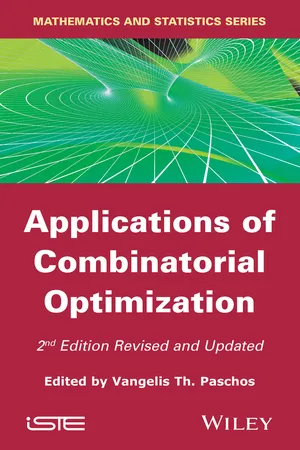Mathematics
Allocation Problems
Allocation problems refer to the process of distributing limited resources among different individuals or groups in an optimal manner. These problems arise in various fields, including economics, operations research, and computer science. The goal is to find the most efficient and fair allocation of resources.
Written by Perlego with AI-assistance
Related key terms
Related key terms
1 of 4
Related key terms
1 of 3
7 Key excerpts on "Allocation Problems"
- eBook - ePub
Approximate Dynamic Programming
Solving the Curses of Dimensionality
- Warren B. Powell(Author)
- 2011(Publication Date)
- Wiley(Publisher)
Chapter 14 Dynamic Resource Allocation ProblemsThere is a vast array of problems that fall under the umbrella of “resource allocation.” We might be managing a team of medical specialists who have to respond to emergencies, or technicians who have to provide local support for the installation of sophisticated medical equipment. Alternatively, a transportation company might be managing a fleet of vehicles, or an investment manager might be trying to determine how to allocate funds among different asset classes. We can even think of playing a game of backgammon as a problem of managing a single resource (the board), although in this chapter we are only interested in problems that involve multiple resources where quantity is an important element of the decision variable.Aside from the practical importance of these problems, this problem class provides a special challenge. In addition to the usual challenge of making decisions over time under uncertainty (the theme of this entire book) we now have to deal with the fact that our decision x t is suddenly of very high dimensionality, requiring that we use the tools of math programming (linear, nonlinear, and integer programming). For practical applications it is not hard to find problems in this class where x t has thousands, or even tens of thousands, of dimensions. This problem class clearly suffers from all three “curses of dimensionality.”We illustrate the ideas by starting with a scalar problem, after which we move to a sequence of multidimensional (and in several cases, very high-dimensional) resource Allocation Problems. Each problem offers different features, but they can all be solved using the ideas we have been developing throughout this volume.14.1 An Asset Acquisition ProblemPerhaps one of the simplest resource Allocation Problems is the basic asset acquisition problem where we acquire assets (money, oil, water, aircraft) to satisfy a future, random demand. In our simple illustration we purchase assets at time t - Vangelis Th. Paschos, Vangelis Th. Paschos(Authors)
- 2013(Publication Date)
- Wiley-ISTE(Publisher)
In many cases, we must cope with constraints that are imposed by real systems. Thus we may have limited resources in terms of memory, which introduces a capacity constraint on the processors. We can also limit the number of tasks that can be executed by a given processor. There may also be availability constraints: certain tasks can only be executed by a subset of the processors.2.2.7.3. Objectives of the allocationThe task allocation problem is by nature a combinatorial problem insofar as a very large number of possible solutions exist. Indeed, if we have n tasks and m processors, the number of possible allocations ismn(not all of them are necessarily feasible). To distinguish between different concurrent solutions, we need to equip ourselves with a measure for evaluating the quality of the allocation. This measure, which we generally call the objective function in the context of optimization problems, can be very varied. It naturally depends on the objective that we wish to achieve with the allocation. It appears explicitly in all Allocation Problems based on mathematical programming techniques. However, in certain heuristic algorithms, it is implicit. Generally, the allocation must allow us to optimize the use of the resources. We will look at some of the most-studied criteria. First we need to explain the notations.We consider a set of n tasks denoted by {T 1 ,… ,Tn} and of m processors denoted by {P 1 ,…,Pm}. Let exec : T × P → IN be a function that gives the execution cost of a task t ∈ T on a processor p ∈ P. This function is general and can represent all systems of processors, homogenous, uniform or heterogenous. In the same way, we define a very general function, comm :T × T × P × P → IN, that gives the cost of communication between two tasks t 1 ∈ T and t 2 ∈ T when they are allocated to the processors p 1 ∈ P and p 2 ∈ P , respectively. We denote an allocation by f : T → P .2.2.7.3.1. Minimizing the execution duration
If we consider that the execution and communication costs are expressed in terms of duration then a possible objective is minimizing the total execution time of the program [BOU 95, HUI 97, WOO 93]:2.2.7.3.2. Minimizing the global execution and communication cost
- eBook - ePub
- Vangelis Th. Paschos, Vangelis Th. Paschos(Authors)
- 2014(Publication Date)
- Wiley-ISTE(Publisher)
In many cases, we must cope with constraints that are imposed by real systems. Thus we may have limited resources in terms of memory, which introduces a capacity constraint on the processors. We can also limit the number of tasks that can be executed by a given processor. There may also be availability constraints: certain tasks can only be executed by a subset of the processors.2.2.7.3. Objectives of the allocation
The task allocation problem is by nature a combinatorial problem insofar as a very large number of possible solutions exist. Indeed, if we have n tasks and m processors, the number of possible allocations ismn(not all of them are necessarily feasible). To distinguish between different concurrent solutions, we need to equip ourselves with a measure for evaluating the quality of the allocation. This measure, which we generally call the objective function in the context of optimization problems, can be very varied. It naturally depends on the objective that we wish to achieve with the allocation. It appears explicitly in all Allocation Problems based on mathematical programming techniques. However, in certain heuristic algorithms, it is implicit. Generally, the allocation must allow us to optimize the use of the resources. We will look at some of the most-studied criteria. First we need to explain the notations.We consider a set of n tasks denoted by {T 1 , …,Tn} and of m processors denoted by {P 1 , …,Pm}. Let exec : T × P → IN be a function that gives the execution cost of a task t ∈ T on a processor p ∈ P . This function is general and can represent all systems of processors, homogenous, uniform or heterogenous. In the same way, we define a very general function, comm : T × T × P × P → IN, that gives the cost of communication between two tasks t 1 ∈ T and t 2 ∈ T when they are allocated to the processors p 1 ∈ P and p 2 ∈ P , respectively. We denote an allocation by f : T → P .2.2.7.3.1. Minimizing the execution duration
If we consider that the execution and communication costs are expressed in terms of duration then a possible objective is minimizing the total execution time of the program [BOU 95, HUI 97, WOO 93]:2.2.7.3.2. Minimizing the global execution and communication cost
- eBook - ePub
Game Theory
A Modeling Approach
- Richard Alan Gillman, David Housman(Authors)
- 2019(Publication Date)
- Chapman and Hall/CRC(Publisher)
Chapter 9Resource AllocationThe central mathematical problem in this chapter is that of dividing assets fairly among a group of agents. We suggest several reasonable allocation methods, describe fairness properties in order to characterize some of the allocation methods, and build bargaining, coalition, strategic, and incomplete information game models. We finish with a comparison of the multiple approaches.In previous chapters we began by defining a game which served as a model for a variety of scenarios. Now that we have the modeling tools associated with a variety of games, we begin with a scenario and investigate how different games can serve as models.Inheritance. Bob, Carol, and Doug have inherited equal shares in their mother’s estate, which consists of a cabin, a car, silverware, and $6,000 in cash. The three siblings are friendly with each other, but it is important that they each believe that the division of property is fair. They have differing views about the worth of each item; however, each thinks that the cabin makes up a majority of the estate’s value, and so the person receiving the cabin will need to give money to the other two siblings to even up the final distribution. The siblings must decide how to divide up the estate [41 ].Since the siblings are willing to exchange money to help ensure each receives an equal share of their mother’s estate, we will assume that each can ascribe a monetary value to each item as shown in Table 9.1 .Table 9.1 Inheritance Monetary ValuationsItem/Sibling Bob Carol Doug Cabin $66,000 $60,000 $42,000 Car $10,000 $12,000 $7,000 Silverware $17,000 $27,000 $11,000 Cash $6,000 $6,000 $6,000 Estate (sum) $99,000 $105,000 $66,000 9.1Resource Allocation Problem To begin modeling this scenario, we first recognize it as a resource allocation problem.Definition 9.1.1. A resource allocation problem consists of the following:1.A finite (possibly empty) set L of items.2.A fixed amount M of money.3.A finite set N ofn ≥ 2 - Amit Kumar Gorai, Snehamoy Chatterjee(Authors)
- 2022(Publication Date)
- CRC Press(Publisher)
The assignment problem can be represented through binary integer programming in which the goal of the objective function is to minimize the cost or time of the given assignment. Suppose m jobs are to be assigned to n workers. Each worker can do each job at a specific duration with different efficiency. Let C ij is the cost or time for assigning the resource i to job j. The problem is to find an optimal assignment (which job should be assigned to which worker one-to-one basis) so that the total cost or time of performing all jobs is minimal. The mathematical form of the assignment problem becomes: Minimize Z = ∑ i = 1 n ∑ j = 1 m C i j x i j Objective Function Subject to, ∑ j = 1 m x i j = 1, i = 1, 2 … n Job constraints ∑ i = 1 n x i j = 1, j = 1, 2, …, m Resource/worker constraints The variable x ij can. be either 0 or 1, depends on the assigning and non-assigning the worker i to job j. That is, x i j = { 1, i f i t h w o r k e r i s a s s i g n e d j t h j o b 0, i f i t h w o r k e r i s n o t a s s i g n e d j t h j o b The model represents a special form of the linear programming model, known as 0-1 programming or binary integer linear programming. The objective function represents the total cost or time of performing all the jobs. The job constraints indicate that only one job is done by i t h resource (i = 1, 2,…, m). Similarly, the resource constraint indicates that only one worker should be assigned to j th job (j = 1, 2,…, n). An assignment problem can be categorized as balanced or unbalanced. For example, if the number of jobs (m) is equal to the number of resources (n), the problem is said to be a balanced assignment problem. On the other hand, if the number of jobs (m) does not equal to the number of resources (n); the problem is an unbalanced assignment problem. In order to solve the assignment problem, the number of resources has to be equal to the number of jobs (m = n)- eBook - ePub
The Dilemma of Regional Policy
Increasing 'Efficiency' or Improving 'Equity'?
- Stilianos Alexiadis(Author)
- 2017(Publication Date)
- Palgrave Pivot(Publisher)
The problem of efficient choice between available alternatives involves the consideration of objectives in relation to instruments (Vietorisz 1967). Optimisation models require a specification of an operational performance criterion or an objective function which details the quantity/quantities to be maximised (or minimised) subject to certain constraints. Thus,, subject to x ∈ X, where X is a given subset of Euclidean n -space x ⊂ E n and x = (x 1, x 2, …, x n) ′ is a column vector 6 of n choice variables, F (x) is a given real-valued function of these variables, F (x) = F (x 1, x 2, …, x n). It is generally assumed that X is not empty, that is, there exists a feasible vector x, where x is feasible if and only if x ∈ X. Alternatively, x is the vector of instruments, F (x) is the ‘objective’ or the ‘criterion’ function, and the set X of feasible (policy) instruments vectors is frequently called the ‘opportunity set’, reflecting constraints on the instruments. The problem of resource allocation, the main focus of this study, can be interpreted as one of mathematical programming, which according to Kurihara (1964) has the unique advantage of ‘being able to indicate the best possible path to reach a certain economic target if and when there are selective feasible paths and various limitations, institutional, or political nature’ (p. 83). A particular resource allocation is represented by the choice of a particular vector of instruments; the scarcity of the resources by the opportunity set and the competing ends are represented by the objective function, which gives the value attached to each of the alternative allocations. The solution to this problem is to choose instruments within the opportunity set so as to maximise the objective function. Global maximum (or solution): a vector x ∗ for which x ∗ ∈ X ∧ F (x ∗) ≥ F (x),∀ x ∈ X - eBook - ePub
Large-scale Distributed Systems and Energy Efficiency
A Holistic View
- Jean-Marc Pierson(Author)
- 2015(Publication Date)
- Wiley(Publisher)
Under this seemingly simple question lie numerous problems, mostly because the multiobjective optimization needed in the EA scheduling problem is conceived with incompatible objectives, namely, low-energy usage and high performance. That is why, instead of trying to resolve this question as a whole, we are forced to take another path. As we want to find allocations and schedules that are good, we instead need to ask ourselves not the quality of the solution as an absolute, but the quality of the solution in comparison with other solutions. That being said, one should note that this reasoning does not do away with the problem of finding the quality of a solution in an absolute sense.8.2.1 Finding the Optimal Solution Using a Linear Program
In order to be able to compare two different algorithms, we have to either be able to actually quantify what the differences between the metrics of the solutions imply or else be able to rank them according to their respective distance from an optimal solution.To do that, we chose to model the EA resource allocation problem using a set of linear constraints, in order to leverage linear program (LP) techniques to find a solution.LP is a widely used technique [1, 2] for modeling problems and provides tools that allow us to describe a problem as two things: a set of linear constraints and an objective function to be either minimized or maximized. They allow to use several different methods to solve problems, such as the simplex method [3]. The fact that all constraints are linear gives the possibility to understand and model different aspects of the problem more easily and to test the validity of an allocation. For example, say we have a binary variable that represents the existence of a task j on a host h, meaning that if the task j is executing on the host h. We can model the set of constraints as8.1Equation (8.1 ) then indicates that a task can only be executed on exactly one host, and we can use this simple linear constraint to test the validity of an allocation.The set of linear constraints can sometimes contain both integer and rational variables. One should note here that using both integer and rational variables, a problem known as MIP (mixed integer program), is of significantly increased difficulty, on account of the noncontinuous aspects of integer variables.
Index pages curate the most relevant extracts from our library of academic textbooks. They’ve been created using an in-house natural language model (NLM), each adding context and meaning to key research topics.
Explore more topic indexes
Explore more topic indexes
1 of 6
Explore more topic indexes
1 of 4






